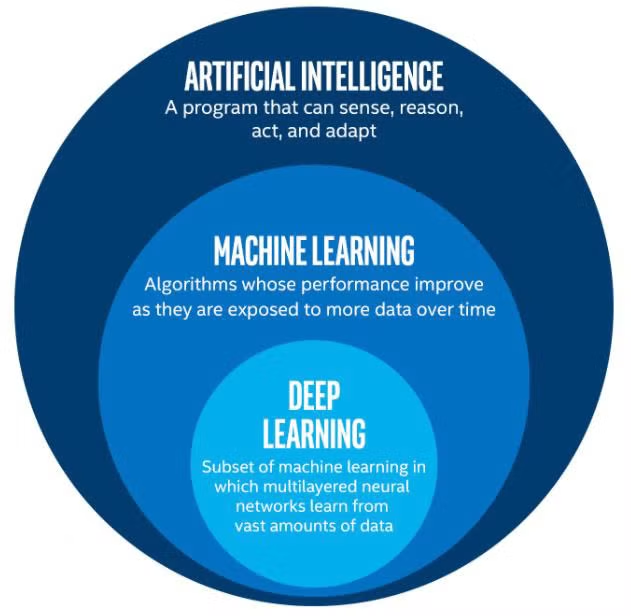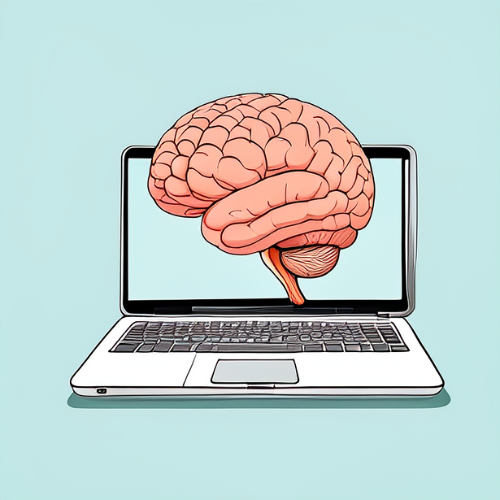Chapter 1: Introduction to Machine Learning#
What is Machine Learning?#
How does Artifitial Intelligence, Machine Learning and Deep Learning relate to each other?#

Artificial Intelligence (AI) is like teaching computers to act smart and do things that normally need human brains - like making decisions or recognizing faces. It’s the biggest category that includes everything else.
Machine Learning (ML) lives inside AI and is more specific - it’s like giving computers the ability to learn from experience, just like how you get better at a video game by playing it more. Instead of being told exactly what to do, the computer figures things out by looking at lots of examples.
Deep Learning (DL) is the smallest category and lives inside machine learning. It works like a super-powered brain, using special layered networks that can learn really complex patterns.
Why do we need Machine Learning?#
Machine Learning helps us solve complex problems faster and more efficiently than humans could do manually. Let me explain this using a simple kitchen analogy!
The Kitchen Analogy#
Imagine teaching someone to bake the perfect chocolate chip cookies:
The Recipe (Machine Learning Model)
Just like a recipe guides you to make cookies, a Machine Learning model guides a computer to make decisions
Both improve with practice and experience
Learning Process
You start with ingredients (data)
Follow a recipe (algorithm)
Taste and adjust (training)
Keep practicing until perfect (optimization)
Real-World Example#
Just like how mastering a recipe helps you make delicious cookies consistently and efficiently, Machine Learning helps us:
Process huge amounts of data quickly (like sorting millions of emails)
Find patterns automatically (like detecting fraudulent transactions)
Make smart predictions (like Netflix recommendations)
Machine Learning has become especially powerful today because we have:
More data available than ever
Powerful computers to process it
Better tools to store and analyze it
Just as no chef starts perfect but improves with practice, Machine Learning models get better as they learn from more examples!
Machine Learning vs Deep Learning#
Aspect |
Machine Learning |
Deep Learning |
|---|---|---|
Best Way to Think About It |
Like following a simple recipe - you know exactly what ingredients (features) affect the taste |
Like a complex restaurant dish - many ingredients interact in subtle ways that even the chef can’t fully explain |
When to Use It |
When your problem is straightforward (like predicting house prices from size and location) |
When your problem involves complex patterns (like recognizing faces in photos or understanding human language) |
Data and Resources |
Works with smaller datasets and basic computers. Like cooking at home with basic kitchen tools |
Needs massive amounts of data and powerful computers. Like running a professional restaurant kitchen |
Exercise: Classifying Machine Learning vs Deep Learning Problems#
Let’s practice identifying whether a problem is better suited for traditional Machine Learning (ML) or Deep Learning (DL).
Scenario |
Your Answer |
|---|---|
You have thousands of customer reviews and want to automatically categorize them as positive or negative sentiment. |
|
You need to analyze thousands of medical X-ray images to detect signs of pneumonia. |
|
You want to predict house prices based on features like square footage, number of bedrooms, location, and age. |
|
You’re building a system to understand and respond to spoken commands in multiple languages. |
2 types of Machine Learning Models:#
Supervised Learning
Unsupervised Learning
Lets first watch this video to understand the difference between Supervised and Unsupervised Learning.
Exercise: Distinguishing Between Supervised and Unsupervised Learning#
In this exercise, you will practice identifying whether a given scenario is best suited for supervised learning or unsupervised learning.
Scenario |
Your Answer |
|---|---|
You have a dataset of labeled images of cats and dogs, and you want to train a model to classify new images as either a cat or a dog. |
|
You want to group customers based on their purchasing behavior without any prior labels or categories. |
|
You are developing a model to predict the price of a house based on its features, such as size and location, using historical data. |
|
You want to analyze a collection of news articles to find common topics without any predefined categories. |
Machine Learning Project Lifecycle#
Just like a restaurant needs a systematic approach to consistently serve delicious meals, machine learning projects need a well-defined lifecycle to deliver successful solutions. Having a structured lifecycle helps teams stay organized, maintain quality, and efficiently handle the complexity of ML projects.
Let’s explore the ML project lifecycle through the familiar lens of preparing a gourmet meal:
Why Do We Need a Project Lifecycle?#
Imagine trying to cook a complex dish without any planning or process - you might forget ingredients, mess up the timing, or end up with an inedible result! Similarly, ML projects need structure to:
Ensure nothing important is missed
Keep the team coordinated and efficient
Maintain quality throughout
Make the process repeatable and scalable
The Key Phases (Through Our Cooking Analogy)#
Problem Definition & Planning
Like planning a dinner party menu based on your guests’ preferences and dietary restrictions
You decide what dish to make and what outcome you want (e.g., “I want to create a spicy Thai curry that my guests will love”)
In ML: Defining the problem you want to solve and what success looks like
Data Collection & Processing
Similar to gathering and preparing your ingredients
You source fresh vegetables, measure spices, and prep everything (washing, chopping, etc.)
Just as you’d remove wilted herbs, you clean your data by removing errors
In ML: Collecting and cleaning relevant data for your model
Model Development
This is like the actual cooking process
You combine ingredients following a recipe, adjust heat levels, and mix everything together
You might try different cooking techniques to get the best results
In ML: Building and training your model with different approaches
Testing & Evaluation
Like taste-testing your dish before serving
You check if the seasoning is right, the texture is perfect, and everything is cooked properly
Maybe have another cook try it and give feedback
In ML: Testing your model’s performance on new data
Deployment & Monitoring
Similar to serving the dish to your customers and watching their reactions
You keep an eye on food temperature, presentation, and customer satisfaction
Make notes on what works and what needs improvement
In ML: Putting your model into production and monitoring its performance
The beauty of this process is its iterative nature. Just as a chef might adjust their recipe based on customer feedback (more spice, less salt), ML projects often require going back to earlier steps to improve the final result. Maybe you need more data (ingredients), or perhaps your model (cooking technique) needs refinement.
Remember: Just as no chef gets a complex recipe perfect on the first try, ML projects typically require multiple iterations to achieve optimal results. The key is to follow the process, learn from each cycle, and continuously improve.
Exercise: Understanding the ML Project Lifecycle#
Let’s practice identifying which phase of the ML project lifecycle different scenarios belong to. For each scenario, select the appropriate phase number:
Phase 1: Problem Definition & Planning
Phase 2: Data Collection & Processing
Phase 3: Model Development
Phase 4: Testing & Evaluation
Phase 5: Deployment & Monitoring
Scenario |
Your Answer |
|---|---|
A startup wants to build a recommendation system for their e-commerce platform. The team is discussing business goals, success metrics, and required resources. |
|
Data scientists are cleaning customer purchase history, removing duplicates, and converting timestamps to a standardized format. |
|
The team is experimenting with different algorithms and hyperparameters to create the best performing model. |
|
Engineers are checking if the model’s recommendations are accurate using a holdout dataset of recent customer interactions. |
|
The live recommendation system’s performance is being tracked, with alerts set up for any unusual patterns in user engagement. |
Machine Learning Terminology Explained Simply
Core Building Blocks:
Algorithm: Think of it like a recipe - a set of specific steps that tell the computer how to solve a problem. Just like how a cake recipe tells you exactly what to do to bake a cake.
Model: The end result after training an algorithm. Like a student who has finished studying and can now take tests. The model takes in new information and makes predictions.
Feature: A piece of information used to make predictions. For example, when predicting house prices, features could be square footage, number of bedrooms, location etc.
Label: The answer we’re trying to predict. Using the house price example, the label would be the actual price of the house.
How We Measure Success:
Accuracy: The percentage of times our model gets the right answer. If it correctly predicts 90 out of 100 cases, that’s 90% accuracy.
Precision: Out of all the times our model said “yes”, how often was it right? Like if a spam filter marks 10 emails as spam, and 9 were actually spam, that’s 90% precision.
Recall: Out of all the actual “yes” cases, how many did our model catch? If there were 20 spam emails total and our filter caught 15 of them, that’s 75% recall.
Bias: When our model consistently makes the same type of mistake. Like always underestimating house prices in a certain neighborhood.
Working with Data:
Training Set: The data we use to teach our model, like flashcards used to study for a test
Test Set: New data we use to check how well our model learned, like taking the final exam
Validation Set: Extra data we use to fine-tune our model, like practice tests before the final
Feature Vector: A list of all features for one example, like [1500 sq ft, 3 bedrooms, 2 bathrooms] for a house
Different Ways Machines Learn:
Supervised Learning: Teaching with examples where we know the right answer. Like teaching a child by showing pictures and saying “this is a cat, this is a dog”
Unsupervised Learning: Finding patterns without being told the answers. Like grouping similar songs together without being told their genres
Transfer Learning: Using knowledge from one task to help with another. Like how knowing French makes it easier to learn Spanish
Reinforcement Learning: Learning through trial and error with rewards and punishments. Like training a dog with treats
These concepts form the foundation of machine learning. Understanding them helps grasp how computers can learn from data to make predictions and decisions.
Exercise: Understanding Machine Learning Terminology#
Let’s practice matching machine learning terms with their real-world examples. For each scenario, select the appropriate ML term:
Scenario |
Your Answer |
|---|---|
When buying a house, the price you’re trying to predict |
|
A student who has finished studying and can now take tests |
|
The square footage and number of bedrooms of a house |
|
A recipe with specific steps to solve a problem |
|
The flashcards used to study for a test |
|
A spam filter that consistently misses promotional emails |
|
Out of 100 spam predictions, 90 were actually spam |
|
Learning to group customers without knowing their categories |
|
Using knowledge from face detection to improve object detection |
|
A robot learning to walk through trial and error |
Good Job! You’ve completed the first chapter.#
Let’s move on to the next chapter.

